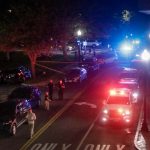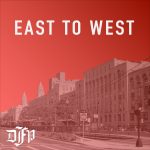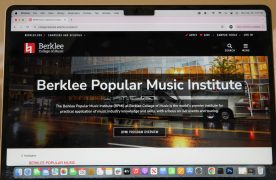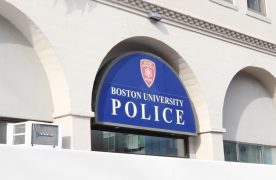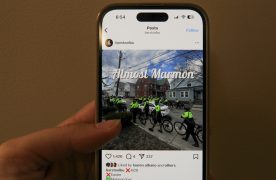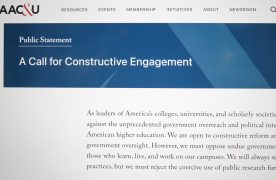The future of Boston University, according to school officials, lies beneath emaciated buildings like the Nickelodeon Theater and 580 Commonwealth Ave.
Or, if not beneath the buildings themselves, then on the land on which they sit.
But as the university dove into the master plan process once again earlier this semester, it demonstrated a keen recognition that its future lies also with its neighbors.
When the BU Community Task Force met Oct. 30 for the first time since December 2001, it began a process to forge the cosmetic and academic future of the university. This process, the renewal of BU’s institutional master plan, is ‘a dialogue’ between BU, its neighbors and the City of Boston, according to John O’Brien, the master plan’s project manager at the Boston Redevelopment Authority.
The master plan is BU’s cookbook for development projects it would like to complete in the next 10 years. Ranging from immediate goals, like construction of the Life Science and Engineering building, renovation of the Nickelodeon and the graduate student apartments at 580 Comm. Ave., to more distant ones, like a new School of Law building, the task force process entails BU, the community and the city, casting a consensus about the size and shape of the university’s growth.
During the compilation of the university’s first two master plans, beginning in 1986, this dialogue was often beset by conflict between the university and its neighbors. And the seeds of those conflicts, whether they be how much land BU owns in Audubon Circle or how many BU students are living off campus, still exist today. But with three meetings down the hatch, the task force and the university have enjoyed almost cordial relations.
The meetings have gone off with nary a raised voice, and what questions task force members have raised have been promptly answered by high-ranking university officials or consultants. To date, Vice President of Government and Community Affairs Edward King and Senior Vice President Richard Towle have attended each meeting.
According to several university officials and task force members, experience and familiarity have been the operative words. Consultants at the first meeting made the point early that the new master plan would be substantially similar to its last incarnation.
‘I think we know the road we’re on, and it’s just going to be some hard work and the participation of the community, which we’re very grateful for,’ Towle said in a phone interview last week.
‘This master plan is basically the same as the past two master plans,’ King said, adding, ‘I think our relationships are 100 percent better with the communities than they were back then. If you don’t have [the support of the community] you’re going to have a tough time getting the permits to build those buildings.
‘We’re going through one of the most important parts of the process right now … once we get the support of the task force we can go before the Boston Redevelopment Authority and get final approval,’ he said.
Based on the first three meetings, task force Chairwoman Pamela Beale said she does not expect any problems with the process.
‘Not from what we’ve seen so far,’ she said, echoing King’s sentiments that the new plan was largely the same as the one approved by the task force in 1997. ‘Things are really starting to come together. A lot of the things that people have been talking about for a long time are finally coming to.’
Beale, who represents the Kenmore Association and has been on the task force since the first master plan in 1986, called the task force process ‘a wonderful opportunity’ for ‘identifying the issues that are important to the students, the community and the university. It gives [the university] an opportunity to hear from people they don’t ordinarily hear from.’
Beale also said the presence of vice presidents Towle and King assured her and several other task force members that the university was serious about their concerns and serious about answering their questions.
‘There is a great deal of give and take,’ Beale said. ‘It gives people a good feeling if people of that caliber are willing to take time. It gives people confidence.’
Task force member and Audubon Circle Neighborhood Association representative Robert Canterbuery said he also has confidence in the process.
‘I’m encouraged by the interaction between the members of the community and the university,’ said Canterbuery, who has been on the task force for about a year. But because the group had not met since December 2001, October was his first taste of combat or the lack thereof.
But Canterbuery said his constituents in Audubon Circle still have very real fears about BU’s expansion.
‘One of our major concerns is air rights,’ he said, referring to the possibility that the proposed Life Science and Engineering building could potentially, once approved and built, expand out over the Massachusetts Turnpike creating an eyesore for his Beacon Street-side community. Such an expansion, however, is not included in the plans that are currently before the task force and would have to be submitted for approval to both the task force and BRA.
Broaching a long-sensitive issue, Canterbuery, who has lived in Audubon Circle for 32 years, also expressed concern about the amount of property BU owns in his neighborhood and the number of students residing there.
‘Boston University owns one quarter of the buildings in Audubon Circle, so with all of the [new dormitories being built] the theory is that the students will move back on campus, but they’re not going to move from university-owned buildings,’ he said. ‘We’d like more permanent residents. That’s a major issue and it always has been a major issue.’
Canterbuery questioned why BU was building on-campus housing for graduate students when he said he and his neighbors would rather have those Audubon Circle buildings full of graduate students, who are more likely to live there year-round. He said when undergraduates filled the apartments, they are vacant for at least three months out of the year.
Despite his concerns, though, Canterbuery said he is optimistic about the process.
‘The task force is project-driven; we don’t discuss anything but projects that are presented to us,’ he said. ‘I like the dialogue that’s going on; I’d just like to see it extended to other issues.’
He also said one of the biggest challenges facing the task force is the pace at which the process is moving – they are simultaneously evaluating three things: the science building, the graduate apartments and the master plan. According to the architects, demolition of the Nickelodeon and 580 Comm. Ave. is tentatively scheduled, pending approval, as soon as this spring.
‘It’s going pretty fast,’ Canterbuery said.
Chairwoman Beale agreed ‘trying to keep on track’ is currently the group’s most daunting task.
And things are proceeding. O’Brien released the BRA’s scoping of the process to date last week at the third meeting. According to O’Brien, the scoping is a compilation of community concerns and additional information that BRA requires the university to include in the final draft of the master plan.
‘I honestly wouldn’t say [the process is] difficu< I would say it's all periods of expressing concerns, hearing concerns and finding remedies,' he said. 'Let's get into each other's heads, and hopefully the document that BU sends back to us expresses the university's interest in continuing the dialogue. 'It's all considered a dialogue.'
This is an account occasionally used by the Daily Free Press editors to post archived posts from previous iterations of the site or otherwise for special circumstance publications. See authorship info on the byline at the top of the page.

